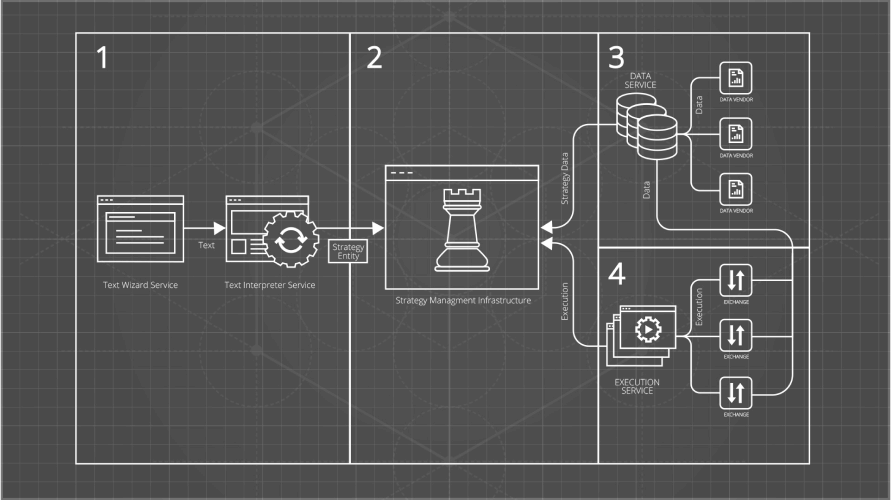A platform is only as good as the technology behind it.
At Capitalise, our platform is shaped by the values that drive our company. We’re committed to providing traders with a straightforward experience without sacrificing quality or features. That’s why we’ve built a platform with a frontend that’s easy to use and made for efficiency, and a backend composed of the most sophisticated, cutting-edge automated trading technology.
The Strategy Creation Wizard and language interpreter
Users begin their journey on our platform with the Strategy Creation Wizard. Here, they can use natural English language to describe trading conditions and actions, which the automated trading software will automatically execute if and when that scenario occurs. This way, it’s possible for anyone to automate trades, no coding knowledge required.
Capitalise takes those words and translates them into a language that the computer can understand: trading algorithms — computer-speak for automated instructions. Our top-tier tech recognizes grammar, syntax, and sentence structure, then deconstructs it to identify singular components like conditions, actions, and relationships.
To keep things completely current, we regularly add new words to our database and our language interpreter understands common synonyms — so you won’t have to spend any extra seconds guessing which word the automated trading platform will accept.
As if that’s not enough, the platform usually knows what you’re trying to say before you do. Okay, well not exactly — but the predictive text feature does offer some pretty solid suggestions on how to set up your strategy, serving both as inspiration and a time-saving tool. As you type your conditions into the wizard, it’ll display a list of suggestions based on previous inputs and the collective behavior of the Capitalise Platform’s user base.
Your strategy in action
Sure, at a high level, it’s pretty easy to explain what’s going on here. But what happens behind the scenes?
To start, investor instructions are incorporated into a strategy to create the Strategy Entity, which is then uploaded to a distributed cloud service. Next, this newborn Strategy Entity subscribes to market data collected from external vendors. Lastly, it deploys trades across integrated exchanges or brokers within the market, effectively automating your trades from start to finish.
The Strategy Management Infrastructure runs all your automated trading strategies at once.
Of course, that algorithm is useless without a means to execute it. That brings us to the Strategy Entity, the logical unit that manages the algorithm. After the trader’s words are turned into an algorithm, that algorithm is incorporated into the Strategy Entity, which is then uploaded to a distributed cloud service. The Strategy Entity is managed by the Strategies Management Infrastructure, which can run an endless number of strategies simultaneously.
To do its job, the Strategy Entity gathers data via the Market Data Service, then monitors and analyzes this data based on the algorithm. If a trader’s conditions are met, the Strategy Entity sends those commands to the Execution Engine to carry out the strategy.
The Strategies Management Infrastructure is cloud-based and runs on distributed servers. It’s designed for scale, high performance, and robustness.
Market Data Service pulls all the info you need.
The Strategy Management Infrastructure relies on market data from external Data Vendors. Procuring that data is left to the Market Data Service, which pulls and processes relevant information.
Each moment, the Market Data Service processes tick data from tens of thousands of instruments. This includes helpful resources like real-time market data, macroeconomic events, fundamentals, cryptocurrency trading attributes, information about token sales, and social media feeds (on our roadmap). The system also tracks technical indicators (e.g. MA, EMA, RSI, Bollinger Band) and calculates volumes over different time frames. The system integrates more data over time, opening a broader set of feeds to traders building strategies.
Execution Service makes sure your trade goes as planned.
Someone’s gotta make sure that the trade goes according to plan. And on Capitalise, that someone is the Execution Service, which communicates with exchanges and brokers in real time, then manages each and every execution order sent to the exchange or broker. Then, it catalogs the information it receives in return and updates execution statuses accordingly.
Authentication of each transaction follows the method used by its respective exchange or broker. It can be done via OAuth, a generated key (from the exchange), or any other method implemented by the exchange or broker.
Like all other services within the Capitalise Platform, the Execution Service is both redundant and scalable. It’s designed to support a large number of orders associated with multiple exchanges and brokers, and triggered by a diverse array of strategies.
So, there you have it: the magic behind the Capitalise automated trading system curtain. Of course, that’s just a sneak peek — there’s only so much we could fit in a blog post, after all. For more details, check out our FAQs, follow us on social media, and join our Telegram group.
Keep on Capitalising!
